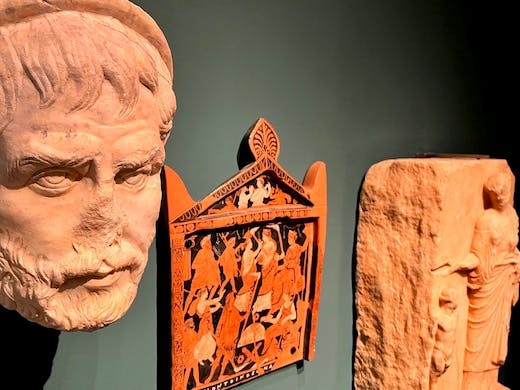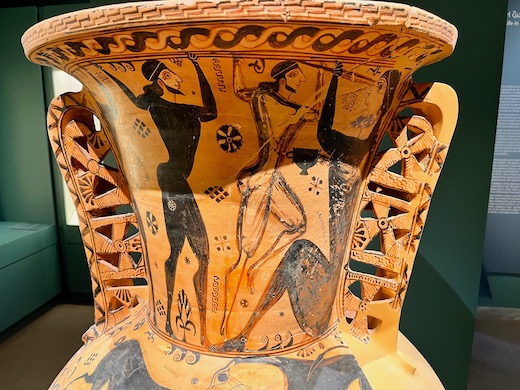Unpacked: A Little Greek Museum of Mysteries Gets a Modern Makeover
Ancient Eleusis, epicenter of antiquity’s most cryptic cult, is ready for its close-up.

The museums of Athens are buzzing as the tourism season winds up, and like every year most tourists will stick to the script, making an obligatory pass at the Acropolis before moseying off to postcard-perfect (if overcrowded) islands like Santorini or Hydra. Yet to do so could mean bypassing some less Instagrammable but more culturally enriching locales within the orbit of the Greek capital, such as ancient Eleusis just 13 miles to the west.
Today the city is called Elefsina, and even though it was designated as the European Capital of Culture for 2023, it is still not a very pretty one, known mostly for its industrial blight and as the home of Greece’s biggest oil refinery. It is also the birthplace of Aeschylus, and it encompasses Eleusis, which was founded in about 2000 B.C. and would become, along with Athens and Delphi, one of the five sacred cities of ancient Greece.
Eleusis expanded around the Sanctuary of Demeter and Kore/Persephone, one of the most important cult centers in antiquity and famously, where the Eleusinian Mysteries took place. These annual initiation rites and sacred rituals, some of which were more mysterious than others, would eventually find their way into rites said to be associated with secret societies as varied as the Freemasons and Yale’s Skull and Bones.
What is certain is that they originally centered on Demeter, the ancient, rich-haired goddess of the harvest, her daughter Persephone, and Hades, who abducted Persephone (with whom he was in love) and led her into his gloomy underworld domain. She wisely only stayed there for a third of the year — winter — and the myth of her reemergence was closely linked with the advent of spring and the many symbolic rites associated with it. The mysteries hinged on sacred initiation ceremonies that traced their roots to the Mycenaean period and possibly even to the Minoans of Crete.
The most important rituals took place in the Telesterion, a fifth-century B.C. temple designed by Ictinos, the architect of the Parthenon. At the center of an immense columned hall stood the Anactoron, or what was considered the Holy of Holies where sacred cult objects were kept.
These could be shown to initiates only by the high priest, the Hierophant, during the torch-lit “night of the mysteries” wherein initiates would break their fasts by drinking the kykeon, a kind of watered barley and mint libation that helped open the door, ancient sources say, to well-being during the mysteries themselves and to the promise of eternal happiness in the afterlife.
It does take some imagination to conjure the 42 columns that once stood here and whatever went on within them, but the monumental ruins of eight rows of rock-cut steps are testament to the size and significance of the original temple.
The Archaeological Museum of Eleusis is not without some magic of its own. It is perched atop a bluff and, like the sanctuary ruins, it is oriented toward the Saronic Gulf and the island of Salamina, in whose waters the Athenian navy whipped the Persians long ago. This all leaves little doubt as to why Poseidon held more sway than Athena in these parts. To find the museum, one must first traverse the ruins of the sanctuary via the ancient Processional Way.
Doing so imparts on the traveler the sensation of reliving, if only for a few moments, some of the ceremonial activity that permeated these quarters well into the Roman period. The museum reopened with a complete renovation earlier this year, to little fanfare. It was funded by both Greece’s ministry of culture and by a sizable donation from the Canellopoulos Foundation, which also funds a hidden-gem museum in the Plaka section of Athens.
The museum at Eleusis is not large and was not on the cultural radar before its renovation, but now it can be considered the most beautiful museum in Attica outside of Athens itself. Visit in the later afternoon after the tour groups have gone, as I recently did, and you will have it mostly to yourself.
It is divided into two main parts: “Eleusis, The City around the Sanctuary” and the “The Great Mysteries.” The first one shows how Eleusis was annexed by Athens and also includes artifacts found in the ancient cemeteries. One of these is a glorious large amphora by the Polyphemus Painter that on its neck depicts Odysseus and his men blinding the Cyclops. The body shows Perseus, having decapitated Medusa, being chased by her frightful Gorgon sisters as Athena comes to the rescue.

blinding the Cyclops. Anthony Grant/The New York Sun
In the second and larger section of the museum, which as you enter begins on the left, one notable artifact among many is a caryatid from the Lesser Propylaea, or gateway, that represents a priestess who carries on her head the cista, or box that kept sacred objects. It is richly decorated with carvings of symbols of the mystery cult like sheaves of wheat, poppies, and kernoi vessels that were used for the worship of Demeter. Elsewhere are displayed smaller ancient objects and votive offerings that illustrate the foundation myths of the Eleusinian cult.
The exhibits have been curated with a deft minimalist touch by a small team of Greek museological experts. The culmination is a dimly lit, reimagined section of the Telesterion during an initiation rite, replete with multimedia elements that contribute to an aura of, well, mystery.
Unpacked is a periodic travel column from Mr. Grant in which he highlights or otherwise deconstructs a destination or experience of potential interest to today’s curious traveler.

